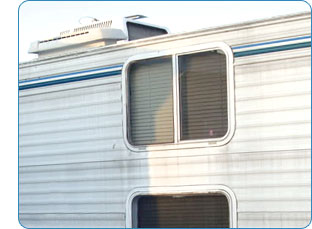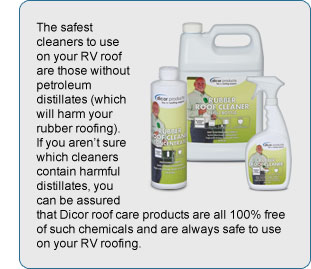 |
|||

Let's explode one myth right away: Now that I've got that off my chest, let me thank you for subscribing to the Rudy RV Improvement Report. This report on black streaks is the first of many handy reports we'll send your way about every two weeks. |
 |
||
 All kinds of airborne pollutants land on your RV roof, including plain old dirt and mold. Many of those pollutants have properties that help them stick around. When a good rain comes, or if you give the roof a good cleaning, the polutants can get dislodged and wash down the RV's sides, only to stick around there, too. On aluminum-sided RVs, such dirt and mold can be aided by the porosity of some kinds of aluminum that exude certain oils, which further help those pollutants bond. If not addressed in timely fashion, they can really get baked in, forming those ugly streaks everyone hates so much. All kinds of airborne pollutants land on your RV roof, including plain old dirt and mold. Many of those pollutants have properties that help them stick around. When a good rain comes, or if you give the roof a good cleaning, the polutants can get dislodged and wash down the RV's sides, only to stick around there, too. On aluminum-sided RVs, such dirt and mold can be aided by the porosity of some kinds of aluminum that exude certain oils, which further help those pollutants bond. If not addressed in timely fashion, they can really get baked in, forming those ugly streaks everyone hates so much.You can also have white streaks of oxidized powder that mix with dirt and reacts in a similar way when it is washed off the roof and onto the sidewalls. |
||
 It sounds simple, but cleaning your roof more often, we recommend 3 to 4 times a year, will help prevent streaks. But if you're going to clean your roof it's important to mask off the rest of your RV's exterior with a drop cloth or plastic to prevent residue from washing off the roof and touching the sidewalls and end-caps. It sounds simple, but cleaning your roof more often, we recommend 3 to 4 times a year, will help prevent streaks. But if you're going to clean your roof it's important to mask off the rest of your RV's exterior with a drop cloth or plastic to prevent residue from washing off the roof and touching the sidewalls and end-caps.
If you don't mask off, at least rinse your sidewalls as thoroughly as you can. For this, a pressure washer with a wide pattern nozel would be good to use after you thoroughly rinse the roof. When the roof is thoroughly dry, for added UV protection you may want to use a roof protectant like Roof-Gard, a spray-and-wipe-on UV inhibitor that educes oxidation and keeps other pollutants from getting a good grip on your roof. The key to remember here is that the black streaks come from dirt, mold, mildew and other pollutants that gather on your roof, so keeping the roof cleaner will go a long way to preventing streaks from forming in the first place. Bye for now. In our next Report we'll talk about how to clean the black streaks if they do take hold on your RV. |
||
You are receiving this email because you have asked to receieve industry related product and service announcements from Dicor Products. If you would no longer like to receive these emails you may unsubscribe at any time using the link below. |